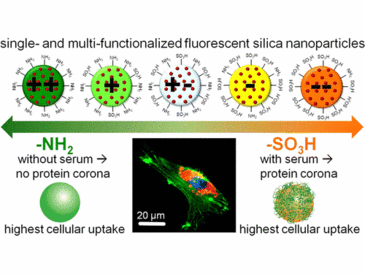Shakiba Shahabi, Laura Treccani, Ralf Dringen and Kurosch Rezwan.
ACS Applied Materials & Interfaces (2015) 7, 13821–13833.
To study the importance of the surface charge for cellular uptake of silica nanoparticles (NPs), we synthesized five different single- or multifunctionalized fluorescent silica NPs (FFSNPs) by introducing various ratios of amino and sulfonate groups into their surface. The zeta potential values of these FFSNPs were customized from highly positive to highly negative, while other physicochemical properties remained almost constant. Irrespective of the original surface charge, serum proteins adsorbed onto the surface, neutralized the zeta potential values, and prevented the aggregation of the tailor-made FFSNPs. Depending on the surface charge and on the absence or presence of serum, two opposite trends were found concerning the cellular uptake of FFSNPs. In the absence of serum, positively charged NPs were more strongly accumulated by human osteoblast (HOB) cells than negatively charged NPs. In contrast, in serum-containing medium, anionic FFSNPs were internalized by HOB cells more strongly, despite the similar size and surface charge of all types of protein-covered FFSNPs. Thus, at physiological condition, when the presence of proteins is inevitable, sulfonate-functionalized silica NPs are the favorite choice to achieve a desired high rate of NP internalization.

![[Translate to English:] Zur Startseite des KKBS](/fileadmin/user_upload/fachbereiche/fb3/kksb/logo/KKSBSchriftMitLogoSchwarz_90.png)
